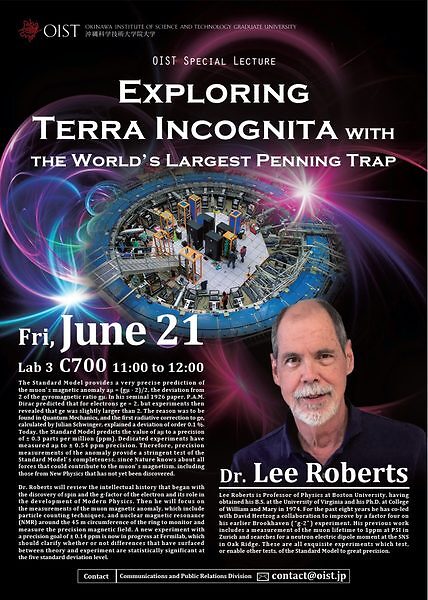Special Lecture - "Exploring Terra Incognita with the World’s Largest Penning Trap" by Dr. Lee Roberts

Date
Location
Description
ABSTRACT:
The Standard Model provides a very precise prediction of the muon’s magnetic anomaly aµ = (gµ - 2)/2, the deviation from 2 of the gyromagnetic ratio gµ. In his seminal 1926 paper, P.A.M. Dirac predicted that for electrons ge = 2, but experiments then revealed that ge was slightly larger than 2. The reason was to be found in Quantum Mechanics, and the first radiative correction to ge , calculated by Julian Schwinger, explained a deviation of order 0.1 %. Today, the Standard Model predicts the value of aµ to a precision of ± 0.3 parts per million (ppm). Dedicated experiments have measured aμ to ± 0.54 ppm precision. Therefore, precision measurements of the anomaly provide a stringent test of the Standard Model’s completeness, since Nature knows about all forces that could contribute to the muon’s magnetism, including those from New Physics that has not yet been discovered.
Dr. Roberts will review the intellectual history that began with the discovery of spin and the g-factor of the electron and its role in the development of Modern Physics. Then he will focus on the measurements of the muon magnetic anomaly, which include particle counting techniques, and nuclear magnetic resonance (NMR) around the 45 m circumference of the ring to monitor and measure the precision magnetic field. A new experiment with a precision goal of ± 0.14 ppm is now in progress at Fermilab, which should clarify whether or not differences that have surfaced between theory and experiment are statistically significant at the five standard deviation level.
SHORT BIOGRAPHY:
Lee Roberts is Professor of Physics at Boston University, having obtained his B.S. at the University of Virginia and his Ph.D. at College of William and Mary in 1974. For the past eight years he has co-led with David Hertzog a collaboration to improve by a factor four on his earlier Brookhaven (“g-2”) experiment. His previous work includes a measurement of the muon lifetime to 1ppm at PSI in Zurich and searches for a neutron electric dipole moment at the SNS in Oak Ridge. These are all exquisite experiments which test, or enable other tests, of the Standard Model to great precision.
Subscribe to the OIST Calendar: Right-click to download, then open in your calendar application.



